Wild edible plants – eat your “weeds” in salad of wild greens
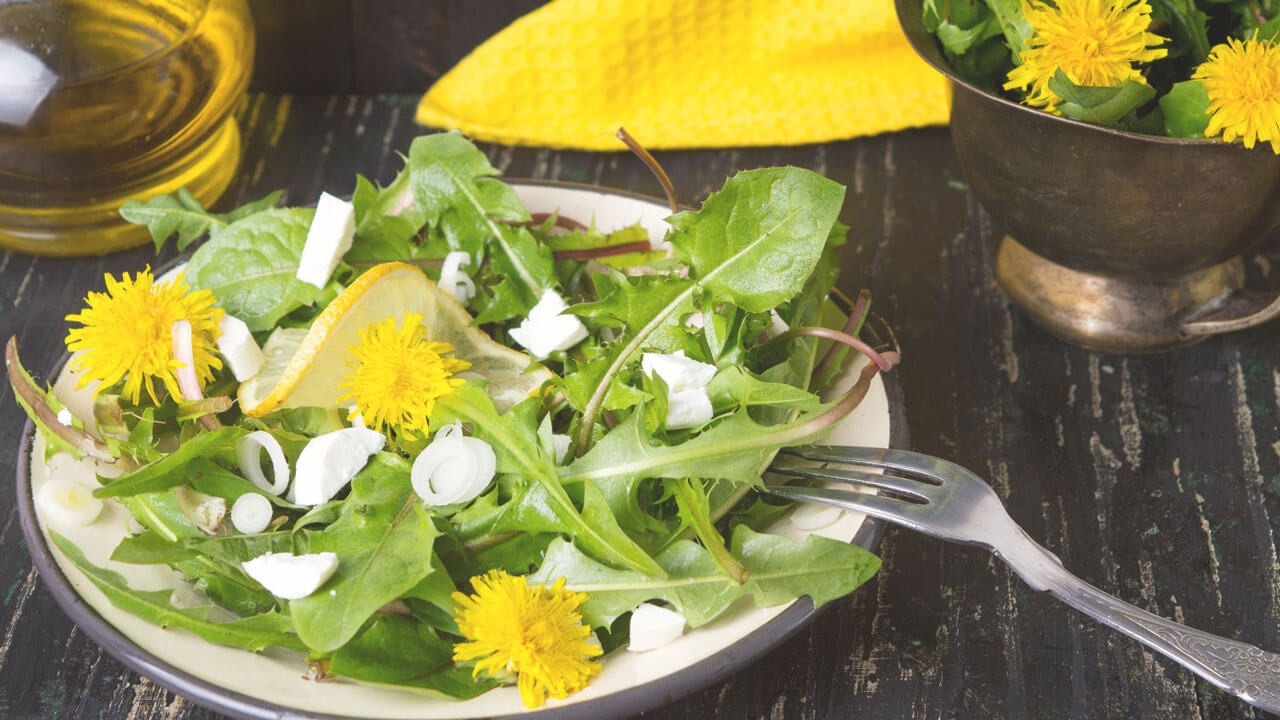
by Corinna Wood
Wild edible plants were my original inspiration for exploring herbal medicine. I began studying the plants because I wanted to be able to look around my yard and know what I could eat!
Over the decades, I've learned many wise woman herbal medicine making practices—and still foraging for wild edible plants remains my favorite of all.
Packed with nutrients and medicinal constituents, these edible wild plants–often considered “weeds”—are deeply nourishing. When you eat these wild herbs, the lines between food and medicine blur . . . and your food becomes your medicine.
And that nourishment is not only physical! Harvesting wild greens reinforces your energetic connection to the land on which you dwell.
I also consider our bodies and the plants to be sacred . . . and I find that the experience of harvesting and eating these gifts of the Earth nourishes body and soul.
Table of contents
Wild edible plants of your foremothers
As you tune in to the seasons of the plants and the natural cycles, remember. . . you’re following a long lineage of your grandmothers’ grandmothers who watched these cycles of moon and sun through the generations.
And you know what? Those foremothers incorporated wild edible plants into their soups and salads!
Throughout time, women worldwide turned to the plants that grew around them as food and medicine.
So, what are the top herbs I turn to for springtime salads? Let’s take a look . . .
Chickweed, gourmet guru of the wild greens
Chickweed (botanically known as Stellaria media) lays the foundation of my wild spring salads. Her tender leaves are mildly flavored and full of nutrients, containing an abundance of vitamin C and chlorophyll.
If you're lucky, chickweed will already have made a home in your garden beds and planters, as she has in mine.
If you're not sure that what you have is chickweed, look for these identifying features:
- Small teardrop shaped or oblong leaves
- A bright white flower with 8 tiny petals
- A line of hairs running along just one side of the stem (the star lady's hairs are tiny, so you may need a magnifying glass for this!)
 In the cool, wet weather of spring and fall, the lush chickweed is my top pick for wild salads.
In the cool, wet weather of spring and fall, the lush chickweed is my top pick for wild salads.
The leaf (and stalk) taste just the way it looks: mild, gentle and bright green.
The easiest way to harvest chickweed is with scissors as if you were giving it a haircut (leave the lower portion of the plant so it can continue producing).
Chickweed is a lovely little wild edible packed with nutrients. Check out my blog article on chickweed for more in-depth information and to learn how to embrace her medicine beyond the dinner table.
Peppercress to spice up your plate of wild edibles
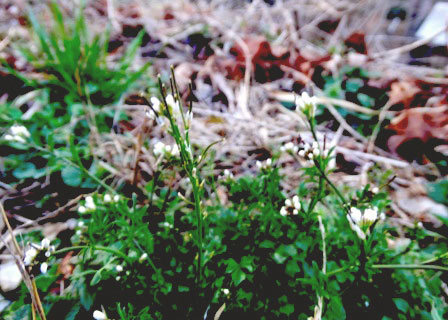 In the cool days of early spring, my heart flutters at my first glimpses of peppercress, poking between the cracks in the pavement or peeking out at the edge of my gardens.
In the cool days of early spring, my heart flutters at my first glimpses of peppercress, poking between the cracks in the pavement or peeking out at the edge of my gardens.
You've probably seen peppercress (Lepidium spp.) an edible wild mustard green that's related to broccoli, with its four tiny white petals on each flower.
She’s a member of a very large and distinguished family—brassicas, also known by the Latin name Brassicaceae—that includes distant relatives such as kale, cabbage, broccoli, collards and cauliflower, as well as closer kin such as mustard greens.
As you learn the family connections of wild plants, their lineage will often give you clues to their nutritional and medicinal properties.
Brassicas are almost universally edible and once you become familiar with their traits, you can safely try them to see if you like the flavor.
The flowers of the Brassicaceae family set them apart. Here’s a quick list to help you identify traits of these wild edible plants:
- Flowers have 4 petals
- Inside the flower are six stamens: 4 tall and 2 short—a distinctive characteristic of the family
- Seed pods occur in a radial pattern around the stalk (in the case of peppercress, they are very long, thin and green, like a mustard seedpod)
Peppercress is a weedy, social plant; it grows in borders and yards, so you don’t have to go foraging way off in the woods to find it. I enjoy its peppery bite, as a snack by itself or in the first wildcrafted salads of the year, mixed with some chickweed—also an early arrival.
Dandelion, wild edible flowers and leaves at your doorstep
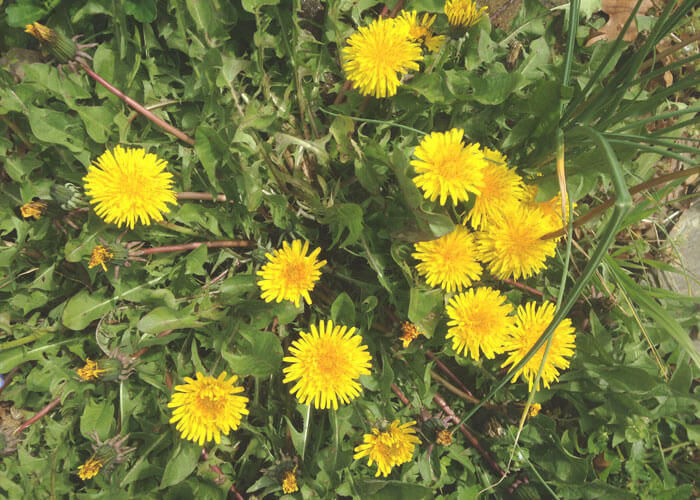 Dandelion (Taraxacum officinale) is probably the most commonly known of the wild edibles.
Dandelion (Taraxacum officinale) is probably the most commonly known of the wild edibles.
When in bloom, look for the bright yellow composite flower—note there’s just one flower per stalk.
To distinguish dandelion from other yellow-flowered composites, look for her toothed leaves and smooth, hairless midrib. And pluck a stalk to confirm that you see a milky latex exuding from the hollow stalk.
While it’s true that dandelion leaves have a bitter reputation, the truth is that those bitter flavors also carry her medicinal value.
Whether you’re making salads or stir-fries, you can begin harvesting dandelion leaves as soon as they start peeking up in the early spring and continue throughout the growing season.
For wild salads, I break up the leaves to distribute their strong flavor. And then top it off with some of her lovely yellow flowers!
Violet to adorn your salad bowl
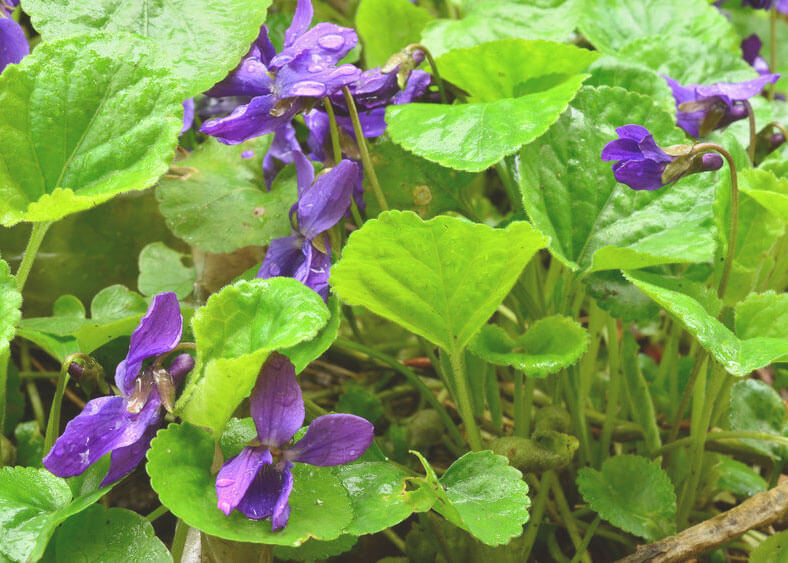 Another common wild edible, violet, is one of the first spring flowers to bloom—around the same time as dandelion.
Another common wild edible, violet, is one of the first spring flowers to bloom—around the same time as dandelion.
In spite of her name, violet (also known as Viola spp.) can be magenta, white, periwinkle, yellow or purple.
She has five petals—4 of the same size and orientation with a fifth narrow petal hanging down like a little tongue.
Her leaves are heart-shaped with scalloped edges and can curl into little spirals where they meet the stalk.
Violet leaves and flowers are always a welcome mild-tasting and pretty addition to my salad bowl. Or I’ll nibble the flowers as I forage for other wild edible plants.
Ground Ivy adds a tidbit of flavor from the mint family
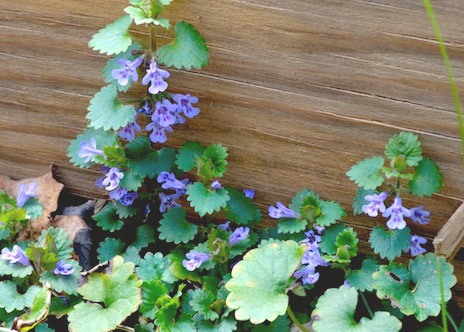 Ground ivy (Glechoma hederacea) is a charming and common wild edible plant, considered a ground cover as well as a weed.
Ground ivy (Glechoma hederacea) is a charming and common wild edible plant, considered a ground cover as well as a weed.
In fact, she’s known to creep about through the garden beds or anywhere else her tendrils can reach . . . lemme just put it this way—she’s no stranger in my yard!
Like violet, ground ivy blooms in early spring adding a lovely lavender pop to lawns and low woodland areas. You can harvest the leaves throughout the growing season, and the flowers as they bloom in spring and early summer.
As a member of the mint family, her identifying features follow the same pattern: square stem, opposite leaves, two-lipped tubular flowers.
Since her flavor can be quite strong, I recommend adding her sparingly to wild salads.
As you know, it's essential to positively identify any plants you're harvesting for food or medicine. First things first: Grab my free guide on 3 Poisonous Plants to Watch Out For (pdf) so you can stay safe on your herbal adventures.
Making a salad with your wild edibles
Making these salads is easy once you get the hang of it.
First things first, it's imperative to positively identify any wild edibles before eating them. When in doubt, consult one who knows.
When I gather wild greens, I collect only the vibrant leaves near the top of the plant.
That way the plant material is free of dirt, washed by the rain and may be added directly to my salad bowl without the need for sorting or cleaning.
That keeps your wildcrafting foray quick and fun, with no washing or pruning required.
You can bring your bowl or basket outside to gather your wild edibles. As you harvest the clean, vibrant green leaves, break them into bite-sized pieces as you place them in your basket—or back in the kitchen.
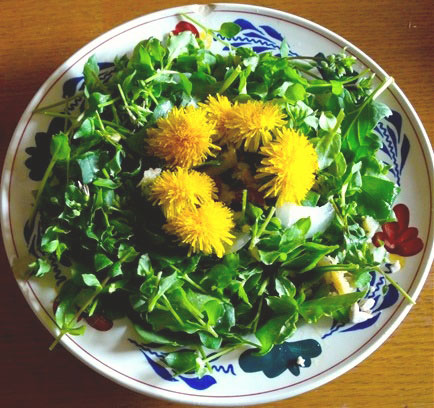
I generally pick one mild-tasting, wild edible herb for the foundation—like chickweed, violet, or lambsquarters (in summertime).
Of course, it's fine to mix in some fresh lettuce or spinach leaves to get you started.
Next, toss in smaller quantities of strong-flavored wild greens such as dandelion, peppercress, ground ivy, wild onion, ox-eye daisy leaves and/or other wild edibles that you’re familiar with.
If you have violet, dandelion or red clover flowers blooming nearby, by all means, garnish your salad with those beautiful blossoms!
Back inside, top your salad with anything you enjoy—personally, I love to add some crunchy nuts or seeds.
Since almost all store-bought salad dressings are made with low-quality oils, I like to dress my salads with a simple homemade mixture of olive oil with a bit of lemon juice or my favorite vinegar, garlic (powder or minced), and a pinch of salt.
Just give it a shake before pouring over your bountiful delight.
Wild edible plants for wild women!
Wild edible plants are at the heart of my herbalism. No worries about rushing yourself to get to know every one of the herbs listed in this article right away.
Take it slowly.
Focus on one plant at a time and watch her grow through the season so you can identify her more readily next time around.
Remember that there’s no one way to do this . . . the name of the game is "simple, messy and fun!"
Wild edibles certainly nourish me physically, and they also nourish me with their earthy beauty.
My heart lifts when wild salad graces my table—knowing that both body and spirit are being fed, for myself and my loved ones.
My students often say that making wild salads from common, local plants is like remembering something you already knew.
Truth is, it’s a powerful way to connect with the wisdom of your foremothers.
Just remember, sister . . . wild plants make wild women!
And eating the wild plants is always my favorite way to receive their benefits, body and soul.
______________
Spread the wild wise woman ways! Link to this article from your website, or share with your friends using this button~
Comments ~ what stands out for you today?








